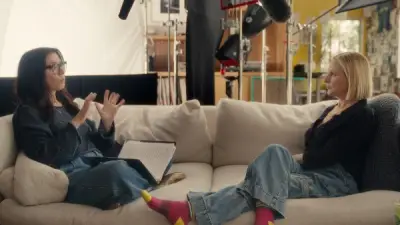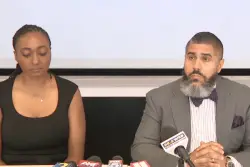Shoshannah Stern on her documentary ‘Marlee Matlin: Not Alone Anymore’

L-R Shoshannah Stern and Marlee Matlin in Stern s film Marlee Matlin Not Alone Anymore Photo provided by Kino Lorber In -year-old Marlee Matlin won the Best Actress Oscar for her role in Children of a Lesser God She is still the youngest person to ever receive the Best Actress award and until was the only deaf person to ever receive an Oscar period At that very young age Matlin was thrust into the spotlight and questioned to represent the requirements of an entire district In the new documentary Marlee Matlin Not Alone Anymore filmmaker Shoshannah Stern explores the ups and downs in Matlin s life including her advocacy like her campaign for closed captions her relationship with William Hurt whom she accused of physical and sexual abuse back in and her journey to feeling less alone Stern s film is one of the better celebrity documentaries to come out in latest years in part due to Matlin s willingness to be raw and vulnerable Unlike majority of talking head interviews Stern is not off camera but sitting on a couch with Matlin Stern who is also deaf speaks with Matlin in American Sign Language This means that long stretches of the film play in complete silence giving hearing audiences a peek into the experience of someone with different capabilities Rough Draft Atlanta in recent weeks spoke with Stern about making the film This interview was conducted over email and Stern s answers have been lightly edited for clarity How did you and Marlee Matlin initially meet What did it feel like to have her recommend you to direct this film Shoshannah Stern We met the first year I started acting in Los Angeles on maybe the fourth television show I ever booked called The Division We guest starred on that together which was a dream come true for me I really enjoyed working with her and was awestruck when she demanded to keep in touch when we wrapped We developed a friendship after that and while we ve tried to find projects to work on together for a while now including This Close the television show I co-created and co-wrote I had absolutely no idea she d recommended me to direct this film until much later in the process I knew I couldn t say yes without her blessing so once I learned it had veritably been her idea the magnitude of that gave me that extra courage I needed to listen to everything my instincts were telling me about what this film needed to be in order to tell her story the way I felt it should be informed The interview style in this documentary is very casual and unlike other docs you re in the frame Can you talk about making those decisions and what sort of atmosphere you wished to create Stern That was a very conscious choice I made based on several factors One reason was that sign language is a visual language so I knew the audience would need to see me in the same way they re used to hearing the interviewer ask questions especially when there are follow-ups I was really excited about reconfiguring the form of documentary in that way by using split screens to reimagine visual voiceovers and discovering how using a visual language could push and shape the form of documentary as we know it I decided to put myself on a couch with Marlee because I knew that we would be talking about intimate things so it was essential for me to create a safe and confident context for her I recounted her that rather than it being an interview it would be a conversation two women sitting on a couch talking about shared experience It was central to me to make consent paramount in our interview process because she is a survivor I don t think anyone should retraumatize survivors by forcing them to answer questions they re really not ready to answer totally because it gives them the emotion they need for the film When I see moments like that it feels painful for me as well like I m witnessing something I shouldn t I want to believe there s another way to do it by sitting with them by feeling what they are feeling and offering contextual promotion for that emotion so they know they re not going through any of it alone which is another reason the film is called what it is I read an interview with you where you talked about adding captions for Sarah in Children of a Lesser God for the first time within this documentary You got emotional during that interview and I wondered if you could elaborate on what that meant for you as a person and as a filmmaker Stern I still tear up every time I see that scene and I must have seen it hundreds of times by now after all the edits we ve done Like anyone who s read the script knows Sarah s lines are scripted in the play So I unfailingly knew what she was saying but if you haven t done the play or had the opportunity to read it you will never know That s because the device of both the play and the film is that James speaks for Sarah but in that particular moment he chooses not to Instead he keeps her words for him and him alone By doing that he ends up robbing Sarah not just of her voice but of her agency Because the audience never learns what she s really saying the focus becomes on how she says it and whether the audience understands her or not and it seems like largest part people never do Maybe that s even the conceit of the scene I don t know All I know is that like I say in the film to Marlee I would feel sick every night I did that scene onstage until I realized why long after the fact because that scene feels like a rape James is forcing Sarah to use her voice without her consent and even when she does at last speak the scene is still about him and how the audience perceives her voice It never feels like it s about her or even for her so to be able to definitively give Sarah her voice back will never not be emotional for me One of my favorite devices in this documentary is the way you return to different moments throughout often with more context for the audience the second time around the example I m thinking of is the Oscars and Marlee s win How did you make those decisions regarding structure did you have an idea for how you craved to orient the story going into filming Did something different emerge in the editing room Stern I invariably wished the film to make several cycles because while life is linear the way we process it never is We return to the same places in our life repeatedly in our minds and hearts as we grow and learn more about ourselves and the world around us and then we go oh so that s what really happened So several avenues we interpret moments we live or witness are shaped by different things the senses we lead with the way the practices is in that moment or the way our focus is being pulled We constantly talked about the Oscars being bookends but now that I ve seen the film in theaters several times I think they re more like figure eights Sara Newens our editor has been with me from the start and was the the majority incredible collaborator anyone could ask for We spent hours talking about this structure and she understood it instantly as did our producer Robyn Kopp Marlee published a memoir in and she covers a lot of what this documentary covers in that book Yet I still discovered that this documentary felt like a fresh take on her life How did you work to differentiate the movie from her book Stern I invariably spoke about this film being a reframing and a contextualizing of her story That s what I required it to be and what it consistently felt like the film requested to be as well I literally felt like because the book was already out there it freed us up because there was nothing we felt like we were digging at or searching for It was the story of a woman who was brave enough to reveal so much of her life especially when she was thrust into representing an entire society to the world at such a young age and how our society received that bravery It felt like the job of the film was to expose how stories limit our perception of people especially if that story hasn t been described from someone who has lived that experience themselves I requested to show just how different the stories can be if you shift that perspective by allowing the audience to immerse themselves into it At one point while speaking with Aaron Sorkin you make the report that every deaf actress has played Sarah in Children for a Lesser God at several point partly due to a lack of other stories about deaf characters The movie is bookended with the CODA Oscars which was only a couple of years ago Maybe you don t feel this way but it feels to me like the evolution of deaf characters on screen is moving at a bit of a slower clip than other communities Do you have any thoughts on that evolution I talked a lot during the editing process about Chimamanda Ngozi Adichie s TED talk about the danger of a single story One person or one story cannot accurately define an entire neighborhood Stories are often a reflection of the times they are in and not all of them age well I ve often revealed just like Marlee was alone for a long time Children of a Lesser God was as a story too Our society likes to decide who gets to tell stories and why and while we need more stories as various of them as we can get I m hoping that our film shows the value of the storyteller and why who they are matters so very much I loved what Aaron stated about it not being hard to write for deaf people because it is true it is not hard at all They ve been here as long as there have been people and have been around for every turning point in history but we haven t seen them there Until we do and until we see them represented in of the stories we see because the estimate is we make up of the world you re right the evolution of their presence in stories necessities to increase considerably and at a much quicker pace Chop chop The post Shoshannah Stern on her documentary Marlee Matlin Not Alone Anymore appeared first on Rough Draft Atlanta

